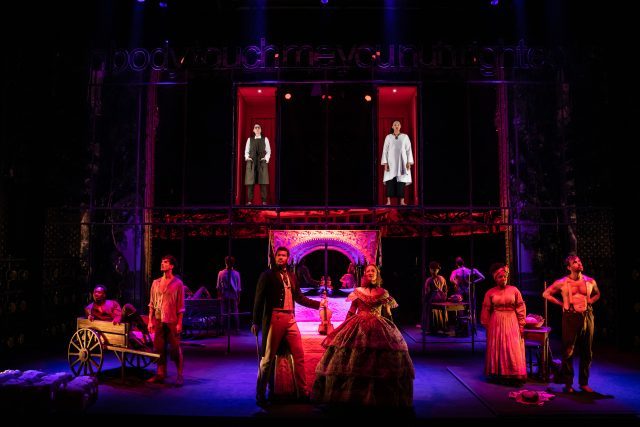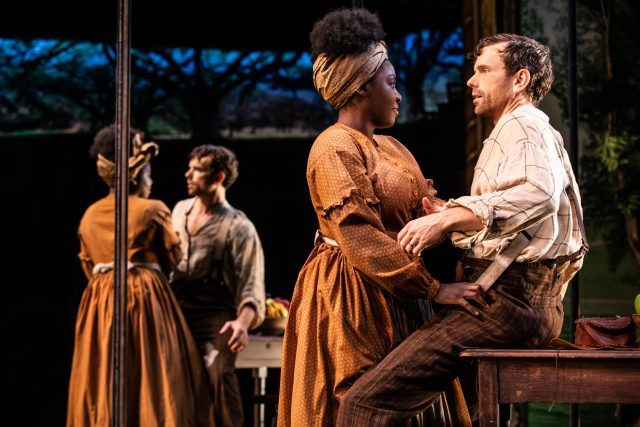
Jeremy O. Harris’s Slave Play has moved from New York Theatre Workshop to Broadway (photo by Matthew Murphy)
Golden Theatre
252 West 45th St. between Broadway & Eighth Ave.
Tuesday – Sunday through January 19, $39-$159
slaveplaybroadway.com
Over the last several years, I’ve had the privilege of seeing four terrific shows first off Broadway and then on, then on the Great White Way. In each case, nothing was lost in the transition to the bigger stage; in fact, three of them received Tony nominations for Best Play — Indecent, Pulitzer Prize recipient Sweat, and The Humans — with The Humans winning the award. (Unfortunately, the sadly overlooked Significant Other had only a short stint on Broadway.)
So at first I was surprised to hear that Jeremy O. Harris’s Slave Play, which initially ran at New York Theatre Workshop last season, was heading to the Golden Theatre for a Broadway engagement, not least because of its graphic sexual content as well as its central subject matter involving a trio of dangerous sexual interactions defined by race, gender, and power on a plantation in the Antebellum South as well as today: black slave Kaneisha (Joaquina Kalukango) and her white overseer, Jim (Paul Alexander Nolan); Alana MacGregor (Annie McNamara), the plantation owner’s wife, and her “mulatto” house servant, Phillip (Sullivan Jones); and Dustin (James Cusati-Moyer), a white indentured servant, and Gary (Ato Blankson-Wood), his black boss. Clint Ramos’s set has been expanded, with two levels of mirrored doors that open up to reveal characters and bring on and off various pieces of furniture; the MacGregor plantation is represented by a long horizontal image of the main house on the mezzanine facade that is reflected in the mirrors across the back of the stage so the audience can see itself. At NYTW, the mirrors made it feel like we were all on the plantation, making us complicit in America’s original sin of slavery.

Kaneisha (Joaquina Kalukango) and Jim (Paul Alexander Nolan) face issues of race, gender, and power in Slave Play (photo by Matthew Murphy)
But at the Golden, the mirrors feel more gimmicky, less insightful and condemnatory. The two-hour intermissionless play is divided into three sections, each of which now struck me as being too long and repetitive, continuing well past their expiration date. And the shock value of the brutal sex scenes and, especially, the second-act twist seemed much more tame. The cast, which is the same except for Kalukango replacing Parris — Irene Sofia Lucio and Chalia La Tour are also back as politically correct comic facilitators Patricia and Teá, respectively — is again uniformly strong, with Cusati-Moyer standing out as a white man claiming he’s not white. So what happened? Only small tweaks were made to the script and direction. Perhaps it’s the spate of works by black playwrights about the black experience in America; since Slave Play debuted at NYTW, I’ve seen Jackie Sibblies Drury’s Pulitzer-winning Fairview, Thomas Bradshaw’s Southern Promises, Jordan E. Cooper’s 2019 Ain’t No Mo’, Suzan-Lori Parks’s White Noise, Tori Sampson’s If Pretty Hurts Ugly Must Be a Muhfucka Lynn Nottage’s By the Way, Meet Vera Stark, and Harris’s own “Daddy.”
There’s no denying that it’s a boon to the artform that so many diverse voices are now being heard onstage, both on and off Broadway, dealing with issues that must be faced in a society still teeming with institutional and systemic racism; what used to be the exception (August Wilson, Lorraine Hansberry, Ntozake Shange, Adrienne Kennedy) is quickly becoming the norm (see also Lydia R. Diamond, Dominique Morriseau, Danai Gurira, Dael Orlandersmith, and Katori Hall, among others). But maybe the shock I experienced when I first saw Slave Play has worn off a bit as the subject matter becomes more commonplace in American theater. Maybe the Golden is too large a venue for the intimacy Harris is exploring in the show. Maybe the flaws in Slave Play are more evident in this bigger production, particularly when seen for the second time. Or maybe the novelty of the play has just dissipated as more nuanced ones come along. I’m not sure any of that matters from a critical standpoint, as the producers just announced that it’s off to a solid financial start, even extending the run two weeks.